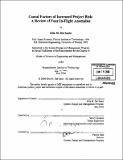| dc.contributor.advisor | Nancy Leveson. | en_US |
| dc.contributor.author | Dal Santo, Rita M. (Rita Marie) | en_US |
| dc.contributor.other | System Design and Management Program. | en_US |
| dc.date.accessioned | 2006-12-18T20:43:00Z | |
| dc.date.available | 2006-12-18T20:43:00Z | |
| dc.date.copyright | 2006 | en_US |
| dc.date.issued | 2006 | en_US |
| dc.identifier.uri | http://hdl.handle.net/1721.1/35115 | |
| dc.description | Thesis (S.M.)--Massachusetts Institute of Technology, System Design and Management Program, 2006. | en_US |
| dc.description | Includes bibliographical references (p. 62-64). | en_US |
| dc.description.abstract | Risk management is an essential component any project. Traditional tools of risk management, however, tend to focus solely on the three traditional project elements-cost, schedule, and technical-ignoring the broader environmental issues which also play a part in project success. Without a knowledge and understanding of these additional factors, incident prevention is not possible. The thesis analyzes four in-flight anomalies to identify the underlying environmental factors that contributed to the technical failures. The major themes found from the in-flight anomalies include the importance of a system perspective throughout the life of the project, the criticality of maintaining excellence during routine tasks, and the experimental nature of the projects. Although nothing can guarantee a project success, research indicated the absence of key elements can set a project up for failure. These key elements include environmental awareness, proficient system engineering, engineering curiosity, engineering humility, and hands-on experience. Additionally, a cursory look at human and system behaviors that lead to resistance to change is provided. | en_US |
| dc.description.abstract | (cont.) Best practices and lessons learned from past incidents are provided and recommendations for future projects are suggested. A few of the recommendations are to establish a strong system engineering discipline, to provide hands-on training opportunities, and to improve current risk management practices to include system factors. | en_US |
| dc.description.statementofresponsibility | by Rita M. Dal Santo. | en_US |
| dc.format.extent | 67 p. | en_US |
| dc.format.extent | 3872781 bytes | |
| dc.format.extent | 3875061 bytes | |
| dc.format.mimetype | application/pdf | |
| dc.format.mimetype | application/pdf | |
| dc.language.iso | eng | en_US |
| dc.publisher | Massachusetts Institute of Technology | en_US |
| dc.rights | M.I.T. theses are protected by copyright. They may be viewed from this source for any purpose, but reproduction or distribution in any format is prohibited without written permission. See provided URL for inquiries about permission. | en_US |
| dc.rights.uri | http://dspace.mit.edu/handle/1721.1/7582 | |
| dc.subject | System Design and Management Program. | en_US |
| dc.title | Casual factors of increased project risk : a review of four in-flight anomalies | en_US |
| dc.type | Thesis | en_US |
| dc.description.degree | S.M. | en_US |
| dc.contributor.department | System Design and Management Program. | en_US |
| dc.identifier.oclc | 71520132 | en_US |
